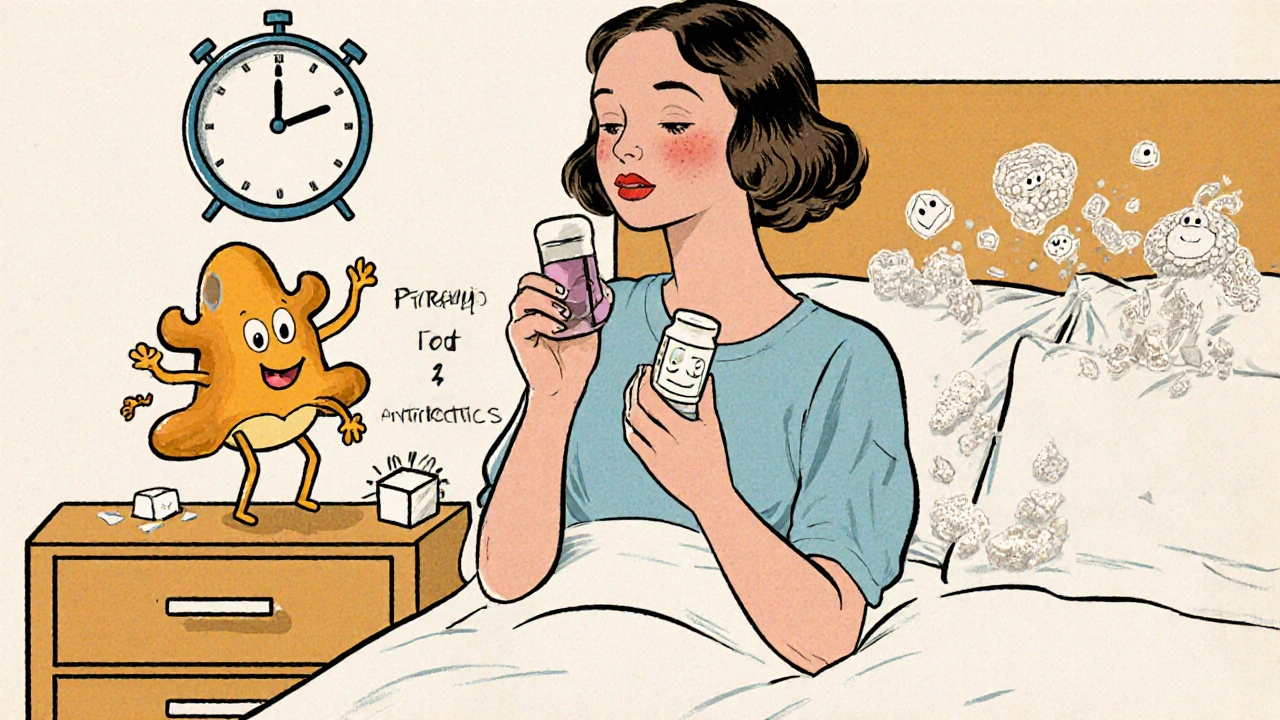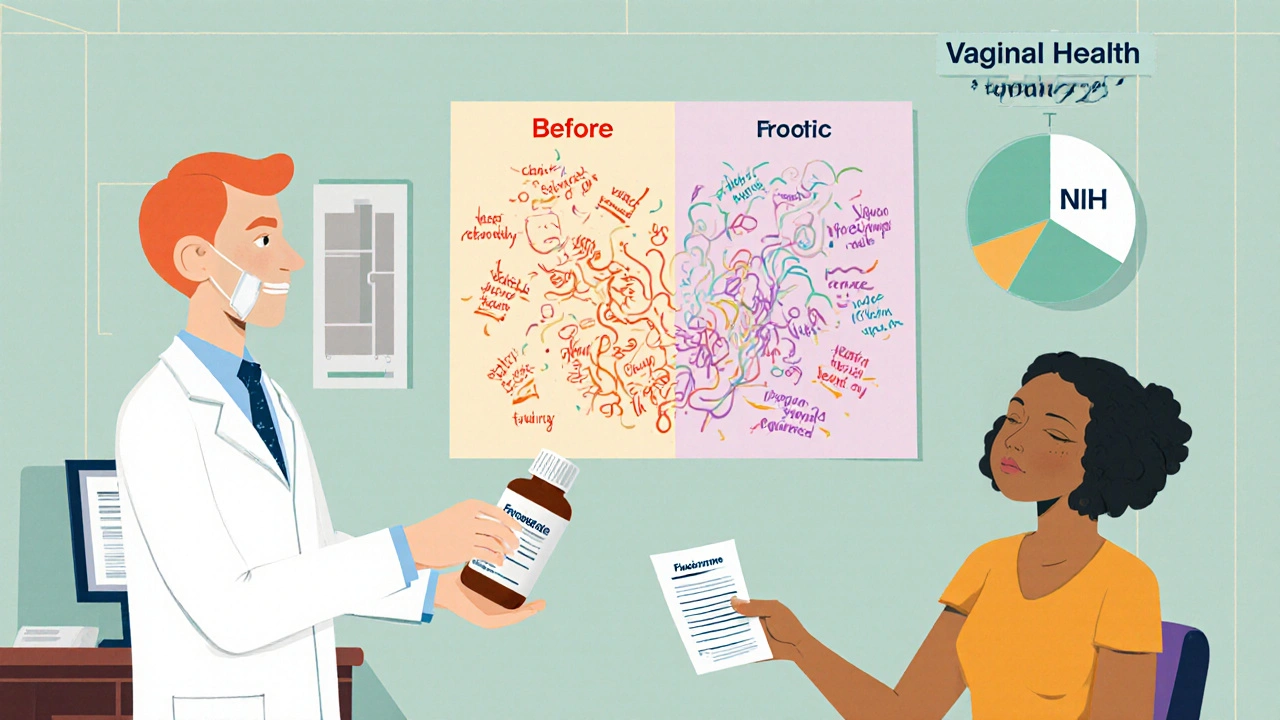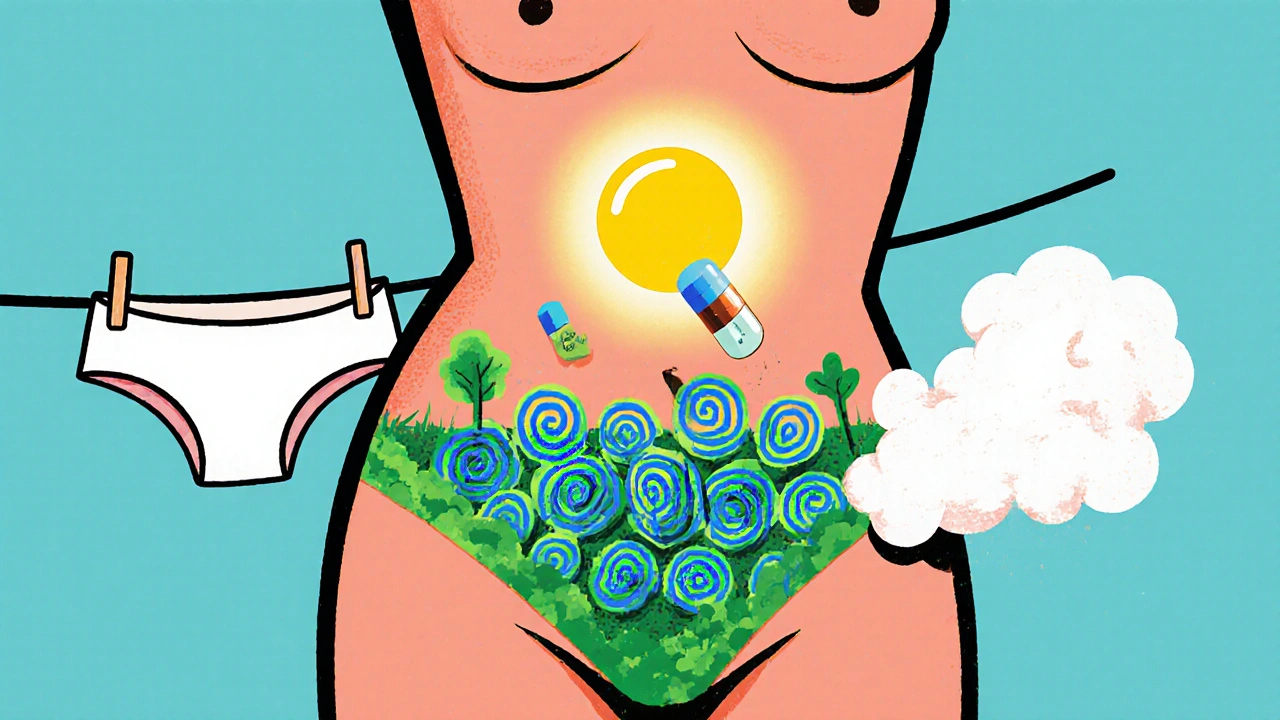Antibiotic Yeast Infection Prevention Calculator
Your Prevention Plan
Enter your antibiotic treatment details and lifestyle habits to get a personalized prevention plan. Based on research from the article, this tool helps you reduce your risk of yeast infections by up to 78%.
When you take antibiotics, you’re fighting bad bacteria. But sometimes, you end up with something just as uncomfortable: a yeast infection. It’s not rare. In fact, up to 30% of people with vaginas get a yeast infection after a course of antibiotics. And it’s not just about itching or discharge - it’s about your body’s natural balance being thrown off. Antibiotics don’t discriminate. They kill the harmful bacteria causing your infection, but they also wipe out the good ones - especially the Lactobacillus that keep yeast in check. The result? Candida albicans, the fungus behind most yeast infections, takes over.
Why Antibiotics Trigger Yeast Infections
Your vagina isn’t just a passageway - it’s a living ecosystem. Healthy vaginal flora is dominated by Lactobacillus bacteria, which produce lactic acid and hydrogen peroxide. This keeps the pH low - between 3.8 and 4.5 - making it a hostile environment for yeast. When you take antibiotics like amoxicillin, tetracycline, or ciprofloxacin, you’re not just targeting the infection. You’re also clearing out these protective bacteria. Without them, the pH rises, moisture builds up, and yeast starts to multiply. It’s not magic. It’s microbiology.Some antibiotics are worse than others. Broad-spectrum ones - the kind that hit a wide range of bacteria - are the biggest culprits. Even a single course can be enough. And it’s not just antibiotics. Steroids, birth control pills, and even some diabetes medications like Jardiance can raise your risk. High blood sugar feeds yeast. Tight synthetic underwear traps heat and moisture. Douching? It washes away your natural defenses. All of these things stack up.
What a Yeast Infection Actually Feels Like
If you’ve had one before, you know the signs. But if this is your first time, it’s easy to mistake it for something else. The classic symptoms are:- Intense itching - often worse at night
- Burning during urination or sex
- Thick, white discharge that looks like cottage cheese
- Redness and swelling around the vulva
But here’s the catch: 64% of people who think they have a yeast infection are wrong. Bacterial vaginosis, trichomoniasis, or even skin irritation can mimic the same symptoms. Self-diagnosing and grabbing an OTC antifungal might make things worse if it’s not yeast. That’s why seeing a provider matters - especially if this is your first infection, or if it keeps coming back.
How to Prevent a Yeast Infection While on Antibiotics
You don’t have to wait for symptoms to start before acting. Prevention works - if you know what to do.Start an antifungal at the same time as your antibiotics. Over-the-counter options like clotrimazole (Gyne-Lotrimin) or miconazole (Monistat) come in creams, suppositories, or tablets. Use the 7-day version, not the one-day dose. Studies show the longer course is 15% more effective at stopping yeast from taking hold. Begin on day one of your antibiotic treatment. Don’t wait for itching to start.
Take the right probiotics. Not all probiotics are equal. Look for strains that actually survive in the vagina: Lactobacillus rhamnosus GR-1 and Lactobacillus reuteri RC-14. These are found in products like Fem-Dophilus. Take 10 billion CFU daily, and take them at least two hours before or after your antibiotic. That timing matters - antibiotics can kill the probiotics if they’re in your system at the same time. Yogurt with live cultures helps, but you’d need to eat a whole cup daily to get enough CFUs. Supplements are more reliable.
Watch what you eat. Sugar feeds yeast. That means cutting back on white bread, pastries, candy, and sugary drinks. It’s not a cure, but research shows reducing simple carbs can lower vaginal glucose levels by 20-30%. Focus on vegetables, lean proteins, nuts, and healthy fats. Avoid alcohol and fermented foods like kombucha - they can also feed Candida.
Ditch the tight clothes. Cotton underwear isn’t just a comfort choice - it’s a medical one. Synthetic fabrics trap heat and moisture, creating the perfect breeding ground. Cotton keeps things drier and cooler. Wear loose pants or skirts when you can. Skip the thongs - they can push bacteria from the rectum toward the vagina. And never douche. Ever. Douching removes 70-90% of your protective bacteria.

What to Do If You Already Have a Yeast Infection
If you’re already dealing with symptoms, you have options. But again, make sure it’s actually yeast. If you’re unsure, get checked.For a first-time, mild infection, OTC antifungals work well. Clotrimazole, miconazole, and butoconazole are all effective. Most people feel better in 3-5 days and are fully healed in a week. If the infection is severe, recurring, or you’re pregnant, you’ll need a prescription.
Fluconazole (Diflucan) is the go-to oral treatment. One 150mg pill usually clears up the infection. But if it’s stubborn, your provider might prescribe three doses spaced 72 hours apart. That’s over 95% effective. However, if you’re pregnant, fluconazole is risky - especially in the second and third trimester. The FDA warns it can increase the chance of birth defects. In those cases, boric acid suppositories (600mg nightly for 14 days) are the safer alternative. They work well, even against harder-to-treat yeast strains.
Don’t try to treat a yeast infection with more antibiotics. That’s a common mistake. Antibiotics don’t kill fungi. They make it worse. One study found 22% of people who thought they had a yeast infection tried taking extra antibiotics - and ended up with a worse infection.
When to See a Doctor
You don’t need to wait until you’re miserable. Call your provider if:- This is your first yeast infection
- You’re pregnant
- It keeps coming back (four or more times a year)
- OTC treatments don’t help after 7 days
- You have fever, chills, or pelvic pain
Recurrent infections mean something else is going on. Uncontrolled diabetes, a weakened immune system, or even an underlying condition like PCOS can be the real cause. Your provider might test your blood sugar, check your immune markers, or even send a sample to the lab to confirm the yeast strain. That’s important - some strains, like Candida glabrata, don’t respond to standard treatments.

The Bigger Problem: Why This Isn’t Talked About Enough
Here’s the uncomfortable truth: vaginal health research is underfunded. The NIH spends $42.9 billion a year. Only 2.5% of that goes to women’s reproductive health. That means we don’t have clear guidelines on how to prevent yeast infections after antibiotics. Most doctors don’t bring it up. Only 38% of OB-GYNs routinely discuss prevention when prescribing antibiotics - even though 89% of patients say they want to know.And the market is messy. Probiotic supplements are sold as “dietary supplements,” not drugs. That means companies don’t have to prove they contain the strains they claim. A 2021 study found 70% of vaginal probiotics didn’t match their label. You’re paying for hope, not science.
But change is coming. Clinical trials are underway for vaginal microbiome transplants - basically, transferring healthy bacteria from donor to patient. There are also pH-balancing tampons in development. These aren’t science fiction. They’re real. But they won’t get funded unless we push for better research.
What Actually Works - The Bottom Line
If you’re taking antibiotics and want to avoid a yeast infection, here’s your simple plan:- Start an OTC antifungal (7-day course) on day one of your antibiotics.
- Take a probiotic with L. rhamnosus GR-1 and L. reuteri RC-14 - 10 billion CFU daily, 2 hours apart from your antibiotic.
- Wear cotton underwear. No synthetics. No thongs.
- Avoid sugar, white flour, and alcohol.
- Don’t douche. Don’t use scented products.
- If you get symptoms, don’t guess - get tested.
This isn’t about being perfect. It’s about being smart. You’re already doing something hard - taking antibiotics. Don’t let a preventable yeast infection add to the stress. You have control here. Use it.
Can antibiotics cause yeast infections in men?
Yes, though it’s less common. Men can develop penile yeast infections, especially after taking antibiotics, if they have diabetes, are overweight, or have unprotected sex with a partner who has a yeast infection. Symptoms include redness, itching, and a white, cheesy discharge under the foreskin. Treatment is similar - topical antifungals or oral fluconazole. Good hygiene and avoiding tight clothing help prevent it.
How long after antibiotics can a yeast infection develop?
Yeast infections can start as early as a few days after beginning antibiotics, but most appear within the first week. Some people don’t notice symptoms until after they finish the course. That’s because the damage to the microbiome builds up over time. Don’t wait until you’re done with antibiotics to start prevention - begin on day one.
Can I take probiotics and antifungals together?
Yes, and it’s actually the most effective approach. Studies show that combining probiotics with antifungals reduces yeast infection rates by 78%, compared to 45% with just one method. Take the antifungal as directed (usually daily for 7 days). Take the probiotic at least two hours apart from your antibiotic - and you can take it at the same time as the antifungal. They work in different ways: antifungals kill the yeast, probiotics rebuild the good bacteria.
Do yogurt and kefir help prevent yeast infections?
They can help, but they’re not strong enough on their own. Yogurt with live cultures contains Lactobacillus acidophilus, which supports gut health. But it doesn’t reliably colonize the vagina. You’d need to eat a full cup daily, and even then, it’s not as potent as targeted probiotic supplements. Think of yogurt as a bonus, not a solution. For prevention, stick with proven strains like GR-1 and RC-14.
Is it safe to use boric acid suppositories?
Yes, for adults - but only if used correctly. Boric acid suppositories (600mg) are effective for stubborn or recurrent yeast infections, especially those caused by non-albicans strains. They’re often used when fluconazole doesn’t work. But never ingest boric acid - it’s toxic if swallowed. Use only vaginal suppositories, not powder or capsules meant for other uses. Avoid if pregnant. Side effects may include mild burning or watery discharge. Always get medical advice before using.
Will drinking cranberry juice help prevent yeast infections?
No. Cranberry juice is often promoted for urinary tract infections, not yeast infections. While it may help prevent UTIs by stopping bacteria from sticking to the bladder wall, it has no proven effect on Candida. Many cranberry juices are also loaded with sugar - which can make yeast infections worse. Stick to water, unsweetened tea, or diluted juice if you want to stay hydrated.


Katelyn Sykes
November 18, 2025 AT 15:59Just finished a 10-day course of amoxicillin and started Monistat 7 on day one like the post said-no yeast infection. I used to get them every time. This is the first time I actually followed the advice and it worked. Also started Fem-Dophilus. No more guessing games. Seriously, if you're on antibiotics, just do this. It's not that hard.
Gabe Solack
November 20, 2025 AT 13:33Same. I didn’t believe it until I tried it. Took the probiotic 2 hours after my antibiotic, wore cotton underwear, and cut out sugar. No itching. No drama. 🙌 I even told my sister and she’s doing it now. Why isn’t this standard advice? Doctors never mention it.